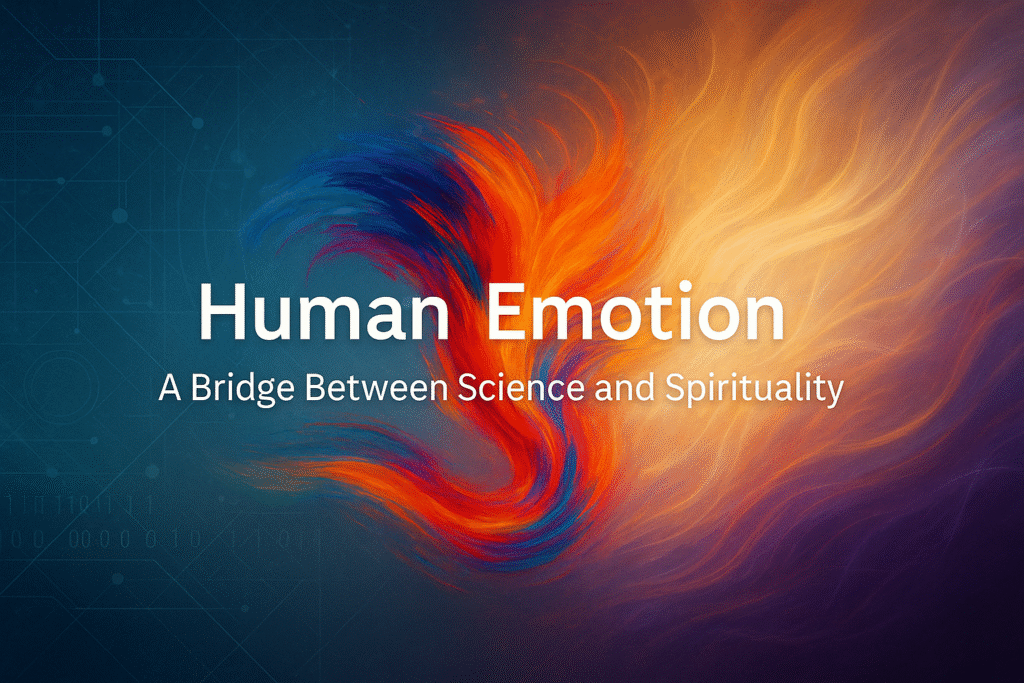Human Emotions

Between two powerful lenses: Science and Spirituality — two worlds that seem different, yet often overlap in beautiful and surprising ways. In part 1, we shared a spiritual perspective on emotion. In this blog post, we’ll explore human emotions through The Scientific Understanding.

The Scientific Understanding of Human Emotions
From a scientific perspective, emotions are biological responses to stimuli, both external (a sudden loud noise) and internal (a memory or thought). They help us adapt, survive, and make decisions.
The Brain (Neuroscience) and Emotions
Several parts of the brain are involved in processing emotions:
-
Amygdala: Triggers emotional responses like fear and aggression.
-
Hippocampus: Connects emotions with memory.
- Insula: Plays a role in the awareness of our internal bodily landscape.
-
Prefrontal Cortex: Helps regulate emotions and control impulses.
-
Hypothalamus: Regulates emotional hormones like adrenaline and oxytocin. Chemicals of FeelingNeurotransmitters and hormones shape how we feel:
-
Dopamine: Associated with pleasure and motivation.
-
Serotonin: Affects mood and well-being.
-
Cortisol: Released during stress or fear.
-
Oxytocin: Deepens connection and emotional bonding.
Physiological Correlates:
Emotions are accompanied by a range of physiological changes mediated by the autonomic nervous system and the endocrine system. These include:
- Changes in Heart Rate and Blood Pressure: Fear or excitement can increase these, while relaxation might decrease them.
- Sweating: The sympathetic nervous system can trigger increased perspiration in response to emotional arousal.
- Respiration Changes: Breathing patterns can shift with different emotions, becoming faster during anxiety or slower during calmness.
- Hormonal Release: Stress hormones like cortisol are released in response to fear or stress, while hormones like oxytocin are associated with social bonding and trust.
- Facial Expressions: The activation of specific facial muscles is a universal aspect of emotional expression, conveying internal states to others.
These physiological responses prepare the body for action and are an integral part of the emotional experience, as proposed by early theories like the James-Lange theory.
Psychological Perspectives and Cognitive Appraisal:
Psychology delves into the subjective experience and cognitive processing of emotions. Cognitive appraisal theories are particularly influential, suggesting that our interpretation and evaluation of a situation are central to determining the emotion we experience.
- Cognitive Appraisal: This is the process by which we assess the significance of an event for our well-being. Factors considered include whether the event is relevant to our goals, who is responsible, and our ability to cope.
- Appraisal Dimensions: Different appraisal patterns are associated with distinct emotions. For example, appraising a situation as dangerous and uncontrollable might lead to fear, while appraising it as unfair and caused by someone else might lead to anger.
Psychological research also explores how emotions influence attention, memory, decision-making, and behaviour. The ability to regulate emotions, or manage and modify one’s emotional responses, is a key area of study in psychology, linked to mental health and well-being.
Evolutionary Purpose
Emotions didn’t evolve randomly. Each serves a purpose:
-
Fear protects us from danger.
-
Anger helps us stand up for ourselves.
-
Love encourages connection and care.
-
Sadness signals a need for support or reflection.
In essence, science views emotions as a survival mechanism, driven by electrical signals and chemical reactions. They’re measurable, observable, and can even be manipulated or balanced using therapy, medicine, or brain training.
Science vs. Spirituality: Two Sides of the Same Coin
Let’s compare both perspectives side by side:
| Aspect | Scientific View | Spiritual View |
|---|---|---|
| Origin | Brain, nervous system, chemical signals | Soul, energy, consciousness |
| Function | Survival, decision-making, and social bonding | Awakening, growth, and karmic healing |
| Identity | Emotions are part of brain function | Emotions are not “you”; they are experiences |
| Healing Methods | Therapy, medication, behavioural change | Meditation, self-inquiry, chakra work, breathwork |
| Ultimate Goal | Emotional regulation and mental well-being | Emotional freedom, spiritual liberation (moksha) |
Final Thoughts: Embracing Both Worlds
Whether you look at emotion through the lens of science or spirituality, one thing is clear: emotions are powerful guides. They carry messages — from your biology and from your soul.
-
Science teaches us how to understand and manage emotions logically.
-
Spirituality teaches us how to accept and transcend emotions soulfully.
You don’t have to choose one over the other. Therefore, the most balanced emotional life comes from blending both: grounding yourself in science while rising through spirit.
“Emotion isn’t just a reaction—it’s a powerful force guiding your reality. Let it connect, awaken, and transform you.”
Reference:
1. Emotions are shaped by complex brain systems such as the amygdala, prefrontal cortex, and hypothalamus, all of which play crucial roles in emotional processing. Learn more about how the brain processes emotions here (Harvard Health).
2. Studies have shown that chronic emotional stress can lead to physical illnesses like heart disease and weakened immunity. Read this study from the American Psychological Association to understand the long-term impact.

